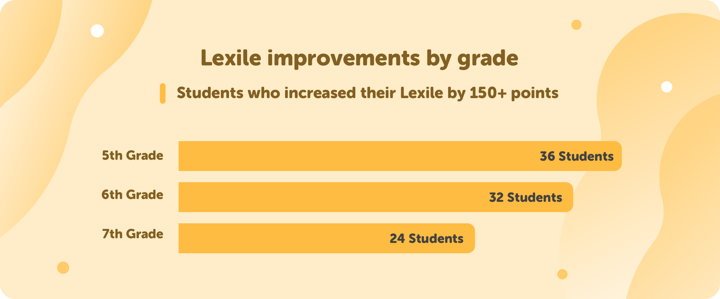Improving reading outcomes after two years of pandemic learning loss is a lofty but crucial undertaking. One southern Georgia middle school is finding real results using Beanstack to lead their reading recovery. In four short months, Mitchell County Middle School tripled their schoolwide reading level improvement goal for the entire year in half the time. They’re on target to improve reading outcomes by double-digit percentages come springtime. Here, we share how they incentivized reading and created a reading culture that’s giving their students big reading gains.

Falling Behind in Reading Comprehension
Heading into the 2021-2022 school year, media specialist Jaycie Holland and her colleagues at Mitchell County Middle School in Camilla, GA, faced daunting challenges to student reading success.
Like many other school populations across the country and around the world, the fifth to seventh grade students in their small southern Georgia community were falling behind in reading comprehension and fluency. The negative impacts of the pandemic and remote learning left their students two to three reading grade levels behind.
In their School Improvement Plan, their principal set a goal to improve student reading levels by 3% in the 2021-2022 school year. “If they can’t read, they’re not going to do well on math tests either,” Holland says. “The principal knew that [reading] needed to be a major goal.”

Building an Independent Reading Culture
School leaders wanted to take an incentive-based approach that encouraged and cultivated independent reading, without putting an extra burden on teachers already overwhelmed by the pandemic. Beanstack’s reading challenges, which use motivational gamification tools instead of quizzes to make reading fun, fit the bill. They rolled out Beanstack for summer reading, and then launched it for all 300 students at the school in August 2021.
Holland worked to build engagement with Beanstack and reading from the get-go. She prepared English Language Arts teachers so that they could support students logging their independent reading during class. Slowly, other teachers began turning to Beanstack when they had downtime. “Even art teachers will remind them if they have extra time,” Holland says.
Holland also turns every Friday into “Beanstack Day,” reminding students during the school’s morning announcements to log their reading. She helps students remember to log when they come to the library, and even devoted a whole day in the fall to promoting the mobile app in the media center. “A lot [of students] added the app to their phones, so they do it from home now too … they were excited about that,” Holland says.
Creating Reading Incentives
To work toward making reading its own intrinsic reward, prizes—even small ones—can help build up kids’ excitement and motivation. Holland created incentives both for accomplishing concrete reading goals and for daily reading. Students can pick small rewards from a treasure chest for logging a certain amount of reading or can win a surprise prize simply for logging on a random day. To cultivate community excitement, Holland works with ELA teachers to set monthly goals for schoolwide reading that they reward with experiences, like a hayride or tailgate party, as prizes.
“Students love it,” Holland says. “Beanstack has really helped some of our students who were not into reading.” She recounts how easy and user-friendly Beanstack’s challenges and logs are for students who balk at writing paragraphs and taking quizzes to count their reading. Quiz-based applications, she says, make them think, “I don’t want to go to the library or get a book today.” With Beanstack, they see how easy reading can be. “Instead, [kids think,] ‘I can really just read this book and log.’ That works for a lot of our students,” Holland says. “Some of our kids were not reading at all [before Beanstack].”

Leaping Ahead With Big Reading Gains
In just the first four months of their school year, Mitchell County Middle School’s students already showed widespread reading engagement through Beanstack. More than 70% of students logged their reading in Beanstack between August and December. And when the school reassessed reading comprehension in December, their students showed huge gains.
To gauge reading improvement, Mitchell County’s school leaders use individual assessments from NWEA’s MAP Suite. Then they add up each student’s Lexile score for an aggregate Lexile value for the school to track progress in the entire school’s reading skills. The school’s total Lexile value increased nearly 10% from the fall to the winter, from 195,650L to 214,445L in the winter. And when they did look at individual Lexile scores, just about one-third of their students improved by more than 150L.

With Beanstack, Mitchell County Middle School is improving reading comprehension at triple the rate they had hoped for—and in half the time. Students are recovering and gaining reading skills at lightning speed. And, perhaps most importantly, they’re finding motivation to read each and every day.
To learn more about how your school can use Beanstack to build a culture of reading, go to beanstack.com/schools.

